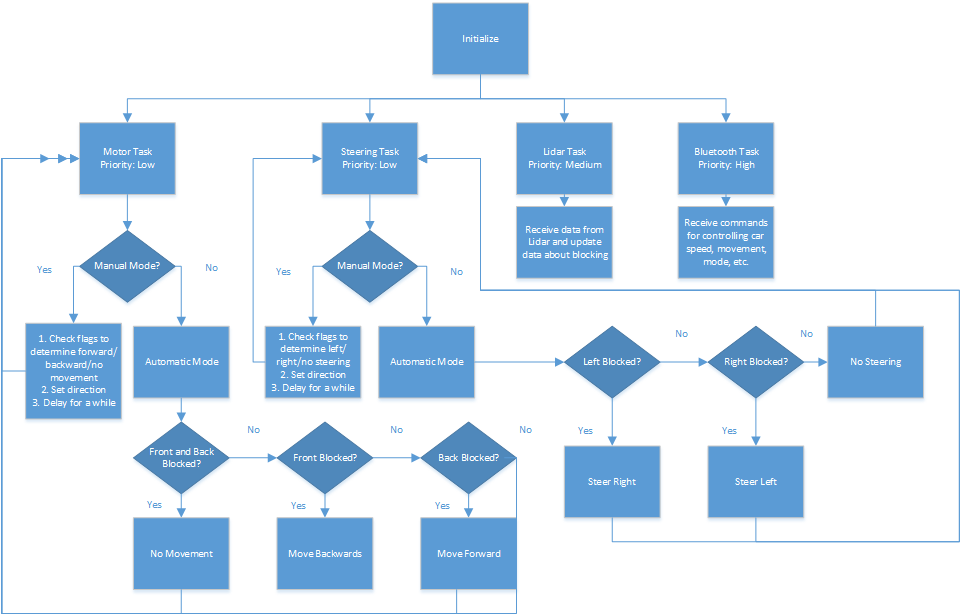Difference between revisions of "F14: Collision Avoidance Car"
Proj user8 (talk | contribs) (→Parts & Cost) |
Proj user8 (talk | contribs) (→Parts & Cost) |
||
| Line 15: | Line 15: | ||
==Introduction== | ==Introduction== | ||
| − | + | <!DOCTYPE html> | |
| − | <table | + | <html> |
| + | |||
| + | <head> | ||
| + | <style> | ||
| + | table { | ||
| + | width:100%; | ||
| + | } | ||
| + | table, th, td { | ||
| + | border: 1px solid black; | ||
| + | border-collapse: collapse; | ||
| + | } | ||
| + | th, td { | ||
| + | padding: 5px; | ||
| + | text-align: left; | ||
| + | } | ||
| + | table#t01 tr:nth-child(even) { | ||
| + | background-color: #eee; | ||
| + | } | ||
| + | table#t01 tr:nth-child(odd) { | ||
| + | background-color:#fff; | ||
| + | } | ||
| + | table#t01 th { | ||
| + | background-color: black; | ||
| + | color: white; | ||
| + | } | ||
| + | </style> | ||
| + | </head> | ||
| + | |||
| + | <body> | ||
| + | |||
| + | <table> | ||
| + | <tr> | ||
| + | <th>First Name</th> | ||
| + | <th>Last Name</th> | ||
| + | <th>Points</th> | ||
| + | </tr> | ||
<tr> | <tr> | ||
<td>Jill</td> | <td>Jill</td> | ||
| − | <td>Smith</td> | + | <td>Smith</td> |
<td>50</td> | <td>50</td> | ||
</tr> | </tr> | ||
<tr> | <tr> | ||
<td>Eve</td> | <td>Eve</td> | ||
| − | <td>Jackson</td> | + | <td>Jackson</td> |
<td>94</td> | <td>94</td> | ||
| + | </tr> | ||
| + | <tr> | ||
| + | <td>John</td> | ||
| + | <td>Doe</td> | ||
| + | <td>80</td> | ||
| + | </tr> | ||
| + | </table> | ||
| + | |||
| + | <br> | ||
| + | |||
| + | <table id="t01"> | ||
| + | <tr> | ||
| + | <th>First Name</th> | ||
| + | <th>Last Name</th> | ||
| + | <th>Points</th> | ||
| + | </tr> | ||
| + | <tr> | ||
| + | <td>Jill</td> | ||
| + | <td>Smith</td> | ||
| + | <td>50</td> | ||
| + | </tr> | ||
| + | <tr> | ||
| + | <td>Eve</td> | ||
| + | <td>Jackson</td> | ||
| + | <td>94</td> | ||
| + | </tr> | ||
| + | <tr> | ||
| + | <td>John</td> | ||
| + | <td>Doe</td> | ||
| + | <td>80</td> | ||
</tr> | </tr> | ||
</table> | </table> | ||
| + | |||
| + | </body> | ||
| + | </html> | ||
==Design Implementation== | ==Design Implementation== | ||
Revision as of 18:43, 21 December 2014
Contents
Collision Avoidance Car
PICTURE HERE
Abstract
The inspiration behind the Collision Avoidance Car project comes from the state-of-the-art field of self-driving cars. All major automotive companies are investing heavily in autonomous car technology. One of the more prominent autonomous cars being developed is the Google Car, which features Lidar and photo-imaging technology to implement autonomy. The goal of the self-driving car is to reduce gridlock, eliminate traffic fatalities, and most importantly, to eliminate the monotony of driving. This project will explore the fundamentals of Lidar, and how this technology is being used for cutting-edge products, such as the Google Car.
Objective & Scope
The project objective was to implement Lidar(laser-based device for measuring distance) technology, coupled with a toy car, to autonomously detect and avoid obstacles. The car operates in two modes: automatic and manual. In the automatic mode, the car maneuvers around autonomously, avoiding obstacles to the front, rear, and sides. Whenever an obstacle is detected, the car maneuvers in the opposite direction, as long as that direction is also free of obstacles. In the manual mode, the car's movements are controlled via a Bluetooth connection. In addition to direction controls, a user is able to adjust the speed of the car and to adjust the distance at which obstacles are avoided.
Team Members & Roles
Eduardo Espericueta - Lidar Unit Integration
Sanjay Maharaj - Motor Integration & System Wiring
George Sebastian - Blue-tooth Integration & Lidar
Introduction
<!DOCTYPE html> <html>
<head> <style> table {
width:100%;
} table, th, td {
border: 1px solid black; border-collapse: collapse;
} th, td {
padding: 5px; text-align: left;
} table#t01 tr:nth-child(even) {
background-color: #eee;
} table#t01 tr:nth-child(odd) {
background-color:#fff;
} table#t01 th {
background-color: black; color: white;
} </style> </head>
<body>
| First Name | Last Name | Points |
|---|---|---|
| Jill | Smith | 50 |
| Eve | Jackson | 94 |
| John | Doe | 80 |
| First Name | Last Name | Points |
|---|---|---|
| Jill | Smith | 50 |
| Eve | Jackson | 94 |
| John | Doe | 80 |
</body> </html>
